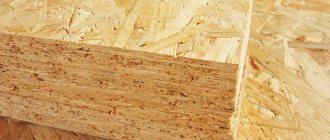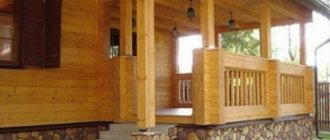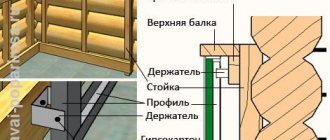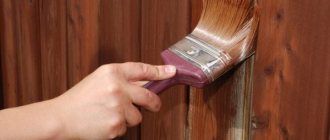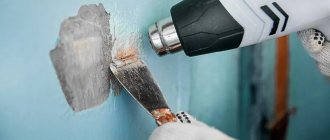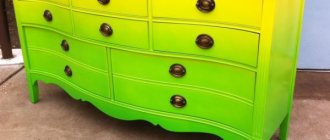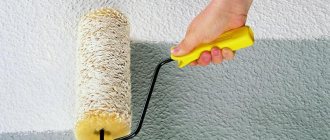Home / Installation, repair, maintenance / Painting / Wooden ceiling - how to paint it?
Wooden floors can most often be found in dachas or country houses. They are painted not only to make the room feel cozy, but also to protect surfaces from pests or moisture. In this article we will look at how to properly paint a wooden ceiling and how to prepare it for painting.
Painting with oil paint
Oil paint requires oil fillers. Such putties are very durable; they will only need to be repainted after five years. Let's prepare a brush.
First you need to check the color and thickness of the paint on a small section of any coating; if everything is satisfactory, we begin to paint. The brush is immersed in paint only a third of its length. It must be kept perpendicular to the ceiling.
The paint is applied stripe by stripe. The stripes must be wide enough; they must be shaded first horizontally, then vertically, from top to bottom. At the same time, turn the brush and do not press it hard. The paint is applied in thin layers.
Before applying new layers, you need to make sure that the previous layer is dry. The first layer is recommended to be painted with a primer paint, and then with the one chosen to decorate the ceiling of the home. Bright, shiny, shining purity of color paint? Or, on the contrary, matte, delicate pastel shade? If your choice is a shiny white color, then before applying white paint to the primer paint, the primer layer must be coated with colorless varnish, dried and then painted with shiny white.
Any oil paint can be top coated with a thin colorless varnish layer; as they say, it will last “longer”.
Ceiling preparation
First, no matter how smooth the ceiling is, it must be leveled with putty or plastered again.
If the ceilings were previously painted with water-based paints, then only damaged areas can be puttied, but you need to take into account that the newly puttied surfaces will differ in color and texture when painted. Therefore, it is better to treat the entire surface.
If the old layer of paint is enamel, and you want to paint it with water-based paint, then the entire surface must be puttied and then primed. After the primer has dried, it must be leveled using fine sandpaper.
Paint for wooden ceilings: 6 types of coating and the best option
Painting a wooden ceiling can present some difficulties not only in the process itself, but also in the choice of finishing material. If we consider the issue from a design point of view, then the best paint is the one that most complements the interior. But we must not forget that wood is a rather “capricious” material, therefore the range of different coatings is quite wide.
Content:
In the case when the ceiling treatment is carried out in a room where there are many wooden elements and the same ceiling, that is, as close as possible to the natural design, it is recommended to opt for a glaze or antiseptic coating.
They have a number of advantages, including:
- Increasing the service life of a wooden ceiling;
- Giving the surface a characteristic shine and light tint;
- Full preservation of wood texture.
If necessary, you can choose a paint with additives, which will make it possible to give the desired shade to the existing material
Specialized construction stores offer a wide selection of wood coatings:
- Acrylic;
- Latex;
- Water-based;
- Silicone;
- Silicate;
- Textured.
Each of them pursues its own purpose, which is described in detail in the instructions for the substance.
Note! Sometimes it may be necessary to apply two or more layers of coating in order for the resulting paint to have a decent appearance.
In most cases, they prefer to choose varnish for wooden ceilings. Considering that interior finishing work is being carried out, it is better to choose water-based acrylic varnishes. This coating dries quite quickly, while preserving and emphasizing the natural grain of the wood.
Varnish protects wood from dust, dirt and water, thereby increasing its service life
Also, depending on the design of the room, the ceiling can be painted with matte or glossy varnish. When choosing conventional paints, preference should be given to acrylate coating, because oil and acrylic are used exclusively for exterior work. The advantages include long-term preservation of the original color, the wood does not fade, and is protected from cracks and the penetration of moisture and steam.
The best paint for a wooden ceiling: evaluation criteria
Unfortunately, it is impossible to give a definitive answer to this question, which is due to many factors: the goals pursued, design, type of wood, etc. Naturally, if the house has a wooden ceiling, then painting is the most correct solution for its reconstructive and primary finishing. Most eco-friendly coatings are white, making them versatile. If necessary, you can add color and give the wood any color.
When choosing varnish or paint, you need to pay attention to the following points:
- The level of coverage of the coating (the ability of the selected material to hide or change the primary finish with minimal consumption);
- Ability to mask defects;
- Adding volume;
- Difficulty in aftercare;
- Price.
All this can be read on the can itself, where the manufacturer indicates the estimated consumption and other characteristics of the coating.
When painting wooden ceilings, it is best to pay attention to water-soluble paints and varnishes
As you can see, there is no definite answer, and there cannot be, because the choice of finishing materials is wide and constantly updated. You can only rely on the presented parameters and, based on the correspondence of the coverage to each of them, make your own choice.
Impregnations and tinting for processing wooden ceilings
If you are the proud owner of a wooden ceiling, then you are incredibly lucky. This finishing material is rich in texture and aesthetics, which is usually only emphasized, but not masked in any way. That is why most craftsmen opt for translucent or transparent coatings that can transmit the required amount of light and slightly tint the wood.
To get this result, you can choose one of the options:
- Glaze with a decorative effect or impregnating varnish. First of all, such a coating performs a protective function, preventing and delaying the process of wood rotting as much as possible. The aesthetic properties of the material appear to the owners in a more pronounced light: the texture is not hidden, the surface is tinted, the varnished element sparkles and shimmers fascinatingly in the rays of the sun and artificial light, and silkiness is felt upon tactile contact.
- Colored varnishes for decorative works. The coating is alkyd, but for all its transparency, it covers the wood with a powerful protective film, and the degree of gloss varies depending on the number of layers.
- Synthetic glaze coating. This varnish is able to penetrate into the deep layers of wood and color it from the inside, which is why they are popularly used when making ceilings made of cheap wood.
Before painting, the wood needs pre-treatment. The protective composition increases its service life, protects it from pests and prevents rotting.
Any of the presented coatings is suitable for treating wooden surfaces made of valuable and ordinary species, as well as their artificial substitutes.
The choice of decorative coating should be approached responsibly, and if there are doubts about its correctness, it is recommended to consult a professional. By the way, construction stores often provide this service free of charge.
Painting a wooden ceiling: main stages of work
It is noteworthy that when painting a ceiling, the whole difficulty lies not in the painting process itself, but in the preparatory stage. If the material is not carefully processed, the final result cannot be called satisfactory.
The preparation is as follows:
- If you are not performing a primary treatment, but a re-treatment of the ceiling, be sure to remove as much of the old coating as possible, and then thoroughly sand the surface, not missing a centimeter;
- After completing the first stage, you should begin grinding the surface; for this, use special sandpaper or a diamond blade, available for purchase in specialized stores;
- The third stage is the use of stain, which will prevent damage to the wood by various insects, and also saturate the material with color;
- At the last stage, we paint the ceiling with a pre-selected material, but only after the previous coating has completely dried.
Visual process of preparing a wooden ceiling for painting
Attention! You should not choose cheap paint, otherwise there is a risk of losing the texture of the wood and ruining the design.
As for the painting process itself, everything is quite simple: you need to work with a brush in one direction, and if several layers are applied, then you need to alternate horizontal stripes and vertical ones.
Choosing paint for wooden ceilings (video)
The paint for wooden ceilings can be absolutely any at the request of the owner. You can coat the material with varnish or a tinted coating, the main thing is to clearly understand what you want to see in the end and go towards your goal.
Attention, TODAY only!
kitchenremont.ru
Main types of coloring materials
There is quite a large selection of paints that are suitable for painting a wooden ceiling. Each of them has its own properties and features of application.
Water-based acrylic paint
Water-based acrylic paint consists of the following elements: water, acrylic resin and a certain pigment for coloring. This paint is universal, since with its help not only ceilings, but also walls, floors and even the facades of a home are painted and acquire aesthetics. In order to minimize paint consumption, it is better to use a spray bottle to apply it. Although the most common method, used even by beginners, is to apply paint using a roller or brush. Please note that the amount of material consumed also depends on the condition of the surface and the quality of the acrylic that is included in the paint. When painting a wooden surface, more substances are consumed than concrete. This is due to the fact that wood has a high degree of porosity and absorbs material very easily. It is enough to apply better quality paint to the ceilings in one or two layers, while cheaper ones will have to be painted at least three layers. Water-based paint has the following advantages:
- water-based ceiling paint is non-toxic;
- has no odor, which gives a certain comfort in work;
- fire resistance, so mainly consists of water;
- after drying, it is resistant to moisture;
- high degree of resistance to low temperatures;
- the ability to retain bright colors for a long time and do not fade;
- painting ceilings is easy and dries very quickly;
- if necessary, you can easily remove a layer of paint during work;
- long period of use;
- After treatment it is easy to care for the surface;
- large selection of colors.
Water-based paint has almost no disadvantages. This is the best option for painting a wooden ceiling.
Based on alkyd elements
Alkyd-based paint consists of almost the same components as acrylic paint, excluding resins. This type of substance is used to give ceilings a glossy shine. Let's consider all the positive characteristics of alkyd-based paint:
- fairly quick drying of the layer applied to the ceiling;
- high degree of reliability, since this type of paint has the ability to penetrate deeply into the surface and be fixed in it;
- the presence of antifungal impurities in the composition, which helps protect ceilings from mold;
- intensity of color tones;
- high degree of weather resistance;
- paint can protect ceilings from rotting.
But it should be noted that alkyd paint also has disadvantages, which, in principle, almost completely cover all its advantages. These include:
- the presence of an odor that is difficult to tolerate, especially for allergic people;
- is not resistant to chemicals;
- instability to fire.
Based on this, experts recommend using this paint to paint ceilings in rooms that have a high degree of humidity in order to ensure reliable protection of the wooden ceiling from the process of rotting.
On polyurethane bases
Quite a capricious substance to work with. This paint should only be applied to carefully prepared ceiling surfaces, which should be absolutely dry. Otherwise, after applying polyurethane paint to moistened wooden ceilings and drying it, the applied layer will swell and crack. The main disadvantage is a very high degree of toxicity. But still, it should be noted that this paint is very wear-resistant.
Oil based
Paint of this type, not so long ago, was the most popular substance for finishing a wooden ceiling, but over time, modern types of painting materials gradually began to supplant it. In the current repair and construction market, this type of paint is significantly inferior in quality to other types. Despite this, many consumers continue to paint ceilings and more with it. It should be noted that oil paint has a high degree of resistance to temperature changes.
DIY ceiling painting
Ceilings do not look aesthetically pleasing at all if the work on painting them is done carelessly and of poor quality. Modern ceiling designs are more varied than before. Original painting of ceilings in several colors with different geometric shapes is acceptable. But not all consumers dare to make such creative solutions; conservatives try to decorate plain water-based ceilings in a conventional style or cover them with paints and paints. But in any case, to obtain high-quality ceilings, it is necessary to use the correct technology for painting them. It consists of two main stages: high-quality preparation and direct painting of the ceiling surface. To achieve the desired result, you need to prepare tools and materials.
Required Tools
Before you begin the main stages of finishing wooden ceilings, you need to prepare the necessary tools, both for preparing the ceilings and for painting them. So, the irreplaceable items that will be needed for the process of painting a large coverage area:
- Rollers. One of the most convenient tools that is used for painting ceilings that have fairly large areas. It should be noted that it is much easier to obtain high-quality painted ceilings using a roller than using a brush. But when purchasing a roller, pay attention to the length of the pile. It should be of medium length. It is more convenient to work with a roller if it has a long handle.
We will also prepare tools that will be used to prepare ceilings for painting with water-based paint:
- Rubber and metal spatulas. Using a metal spatula, you can thoroughly clean the ceiling surface from peeling layers of old paint or dirt. And with the help of a rubber spatula you can fill cracks or chips.
- Chisel. With its help, you can easily get rid of the remnants of old putty or protruding knots or other irregularities that have appeared on the surface of the ceiling.
- Construction hairdryer. This tool will be needed if there is a need to clean the ceiling from several layers of old paint. If the goal is to completely change the design of the ceiling, then you must first remove the old section using a hair dryer, clean the surface and only then apply new paint.
Surface preparation material
When starting to prepare the surface, we pay attention to the materials that will be needed for high-quality leveling of ceilings:
- putty;
- wood primer;
- wooden slats for sealing wide cracks;
- paint for painting;
- solvent for thinning paint.
There are several types of putties that are best used to level the ceilings before painting.
- On an oil or oil-adhesive basis. The composition of such materials includes glue, crushed chalk, drying oil and sicativa - a substance that ensures rapid drying of the material. But, it should be noted that the drying time of this type of putty is still longer than other types. As for strength and reliability, oil putty has high levels of these qualities.
- Acrylic based. They are made from barite or gypsum, talc with the addition of ocher and zinc white. This type of putty is recommended to be used for leveling the surface of water-based ceilings. It fills cracks easily and dries fairly quickly. In addition, acrylic water-based putty is used to level out minor depressions on the surface of ceilings. One of the priority properties of this material is maintaining elasticity, which allows surface deformations not to violate its integrity. One of the conditions for ensuring the reliability of the filling process with water-based putty is careful preparation of the cracks. They must be cleaned of dust and dried.
- Very often, ceilings are leveled using homemade putty. To do this, take small sawdust, add wood glue and mix. This is a fairly high-quality material that is easy to apply and dries quickly.
In addition to filling water-based ceilings, it is necessary to protect the wood from rotting and fungus formation. To do this, you can use drying oil or a specialized primer for wooden ceilings. In addition, the use of a primer will ensure uniform application of paint and minimize its consumption.
Surface preparation
After the tools have been prepared and the materials for the work have been determined, we begin preparing the ceilings for painting with water-based paint:
- Initially, we thoroughly wash the ceilings using detergents.
- Pay attention to the cracks in the ceiling. We clear them of dirt using a chisel or knife.
- If there are greasy stains on the surface of the ceiling, they should be cleaned with a solvent.
- They also remove any uneven surfaces and attach any loose boards with nails.
- A water-based acrylic leveling putty will help to fill all cracks and irregularities.
Ceiling painting
Many people take the process of painting wooden ceilings quite frivolously, believing that nothing can be simpler than painting the ceiling. But, like any other process, applying paint to a wooden ceiling surface has its own specifics. The technology depends on the level of condition of the ceilings.
- Painting the ceiling without visible damage is as follows. To begin with, apply a layer of drying oil to the surface of the ceiling and allow it to dry. This usually takes about 3 days. Then apply the first layer of paint using a roller and again wait for it to dry completely. Subsequent layers of paint are applied in a similar manner. Usually 2 - 3 layers are performed.
- The process of painting a ceiling that has significant defects should be done in the following way. After cleaning the surface, all defects should be thoroughly repaired by filling them. After this, the putty areas should be cleaned with sandpaper. After the material has dried well, begin painting the surface using the technology described in the previous paragraph. To improve the quality of the surface and give it an original appearance, it is recommended to seal the last layer of paint with colorless varnish or special protective oils. They create a glossy appearance to the surface.
- Another method of coloring is improved, according to experts. Its essence lies in the following actions. In one liter of drying oil, dissolve 200 grams of dry paint powder. Cover the ceilings with this mixture and allow it to dry completely. Then a very thin layer of putty is applied, allowed to dry and then stripped. Using this procedure, the ceilings are puttied at least two more times. After this, two layers of paint are applied to the ceiling.
Paint consumption
The optimal paint consumption is considered to be about 200 - 300 grams of solution per square meter. This effect can be achieved by using a roller or sprayer to apply paint. If you use a brush for the painting process, paint consumption increases significantly.
